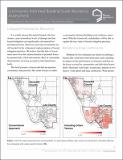| dc.contributor.author | Manav, Ipek Bensu | |
| dc.date.accessioned | 2021-03-02T14:47:56Z | |
| dc.date.available | 2021-03-02T14:47:56Z | |
| dc.date.issued | 2020-02 | |
| dc.identifier.uri | https://hdl.handle.net/1721.1/130017 | |
| dc.description.abstract | It is widely known that natural hazards, like hurricanes, cause tremendous levels of damage and that hazard mitigation can significantly curb natural hazard-induced losses. However, necessary investments are still needed for the widespread implementation of hazard mitigation practices. We believe that this lack of investment stems from the underestimation of potential losses by present tools, which discount the effect of community characteristics on losses accrued by individual households. This brief presents a framework that incorporates community characteristics like urban texture to enable a community-informed building scale resilience assessment. With this framework, stakeholders will be able to capture the true value of hazard mitigation practices. | en_US |
| dc.relation.ispartofseries | MIT CSHub Research Brief; Volume 2020, Issue 1 | en_US |
| dc.subject | Climate Change | en_US |
| dc.subject | Structural Mechanics | en_US |
| dc.subject | Hazard Mitigation | en_US |
| dc.subject | Hazard Resilience | en_US |
| dc.title | Research Brief: Community-Informed Building-Scale Resilience Assessment | en_US |
